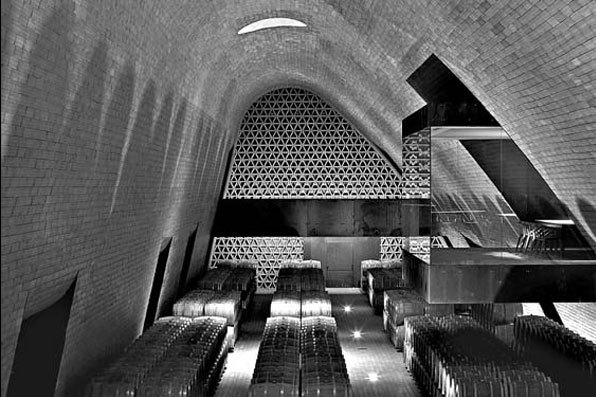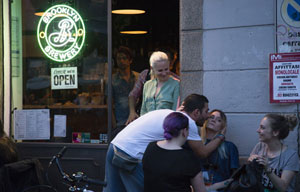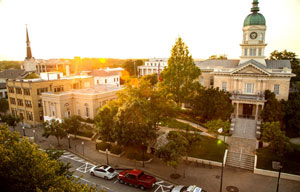Tuscan hill beautified
Vintner's headquarters tucked into the landscape
Bargino, Italy
For all its beauty, Italy has suffered reckless development. Unplanned wastelands of shopping malls, factories and housing projects, many from the 1960s and '70s, sprawl throughout the countryside. Florence, 20 or so kilometers from here, started devolving into a mess of shabby suburbs years ago; nearby towns added industrial parks to historic centers.
Preservationists reined in some of the worst development with stricter zoning regulations. But manufacturing and construction account for nearly one-quarter of the Tuscan economy. Those ugly industrial parks provide jobs. So what should smart growth look like in this region?
|
A soaring corkscrew staircase of steel is a centerpiece of the new 50,000-square-meter, $110 million headquarters of the winemakers Antinori in Italy. Archea Associati |
Cantina Antinori is one answer. From the highway, you can miss the new headquarters that Archea, a Florence firm, has designed here for this prestigious Italian winemaker. The building hides in plain sight, buried into - literally inside - a hill. The architecture doesn't just occupy the landscape, it becomes the landscape. The panoramic terrace is shaded by a curved, deeply cantilevered canopy that is partly camouflaged under rows of young vines.
Once you're inside, the place turns out to be a soaring, light-filled work of contemporary design. At 50,000 square meters, the headquarters, which opened to the public this spring, includes a winery, a 200-seat auditorium, a museum, a restaurant and a shop. The building, which took nearly a decade to complete and cost some $110 million, unfolds as a series of surprises. A snaking driveway deposits visitors into an underground parking lot. Light angles into the lot through circular cuts in the roof.

From the parking lot, visitors ascend the tour-de-force corkscrew staircase made of rust-colored steel, twisting upward like a strip of orange peel. It pops through one of those big cuts onto the terrace, which is nearly 109 meters and echoes the contours of the land. The plaza and canopy make a kind of slash across the brow of the hill, from which the view onto the countryside is wide open.
Through a two-story glass wall lie the offices, museum, shop and the tasting rooms, which are cantilevered over the wine cellars. These are a series of sleek caves as big and somber as cathedrals - spectacular rooms tucked deep inside the hill. The detailing of corners, curves and edges is everywhere crisp and clean. A factory and office complex doesn't have to be a cheap mirrored-glass box or a trumped-up Renaissance villa. It can be Architecture with a capital A.
|
Cantina Antinori is a series of sleek caves, including a vaulted wine cellar with a cantilevered, glassed-in wine tasting room, on the right. Archea Associati |
Antinori is a noble family with winemaking roots dating back 26 generations and is now a major exporter. Antinoris have occupied one of the great palaces in Florence, designed by Giuliano da Maiano, since 1506. Piero Antinori, the reigning patriarch now in his 80s, first hired a local engineering firm to devise a factory and then enlisted Archea to dress the factory up with a facade. But the architects balked.
"This is our oil," was the reaction of Marco Casamonti, a founder of Archea, who oversaw the project. He meant that the region's great cultural and economic resource is its combination of landscape and architecture. Thoughtless development had depleted that resource in this part of Tuscany.
Since it opened, the building has attracted thousands of people, including many architects. The project is all about the beauty of the region and blurring the boundary between landscape and architecture.
Almost 14 hectares were excavated, the building installed, then the hill restored on top of it. So it is purpose-built nature on a very large scale - and a factory.
But it makes peace with its surroundings.
And adds a landmark to them.
The New York Times


















